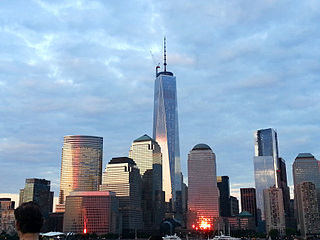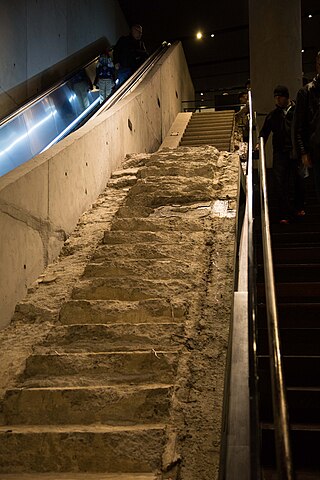
The World Trade Center site, often referred to as "Ground Zero" or "the Pile" immediately after the September 11 attacks, is a 14.6-acre (5.9 ha) area in Lower Manhattan in New York City. The site is bounded by Vesey Street to the north, the West Side Highway to the west, Liberty Street to the south, and Church Street to the east. The Port Authority of New York and New Jersey (PANYNJ) owns the site's land. The original World Trade Center complex stood on the site until it was destroyed in the September 11 attacks.

Daniel Libeskind is a Polish-American architect, artist, professor and set designer. Libeskind founded Studio Daniel Libeskind in 1989 with his wife, Nina, and is its principal design architect.

The National September 11 Memorial & Museum is a memorial and museum that are part of the World Trade Center complex, in New York City, created for remembering the September 11 attacks of 2001, which killed 2,977 people, and the 1993 World Trade Center bombing, which killed six. The memorial is located at the World Trade Center site, the former location of the Twin Towers that were destroyed during the September 11 attacks. It is operated by a non-profit institution whose mission is to raise funds to program and operate the memorial and museum at the World Trade Center site.

The Lower Manhattan Development Corporation was formed in November 2001, following the September 11 attacks, to plan the reconstruction of Lower Manhattan and distribute nearly $10 billion in federal funds aimed at rebuilding downtown Manhattan. It is a subsidiary of the Empire State Development Corporation, which is a New York state public-benefit corporation.

Memory Foundations is the name given by Daniel Libeskind to his site plan for the World Trade Center, which was originally selected by the Lower Manhattan Development Corporation (LMDC) to be the master plan for rebuilding at the World Trade Center site in New York City in February 2003.

The Jewish Museum Berlin was opened in 2001 and is the largest Jewish museum in Europe. On 3,500 square metres of floor space, the museum presents the history of Jews in Germany from the Middle Ages to the present day, with new focuses and new scenography. It consists of three buildings, two of which are new additions specifically built for the museum by architect Daniel Libeskind. German-Jewish history is documented in the collections, the library and the archive, and is reflected in the museum's program of events.
An architectural design competition is a type of design competition in which an organization that intends on constructing a new building invites architects to submit design proposals. The winning design is usually chosen by an independent panel of design professionals and stakeholders. This procedure is often used to generate new ideas for building design, to stimulate public debate, generate publicity for the project, and allow emerging designers the opportunity to gain exposure. Architecture competitions are often used to award commissions for public buildings: in some countries rules for tendering public building contracts stipulate some form of mandatory open architectural competition.

Michael Arad is an Israeli-American architect who is best known for being the designer of the National September 11 Memorial & Museum. He won the competition to design the memorial in 2004.

Peter Walker is an American landscape architect and the founder of PWP Landscape Architecture.
The International Freedom Center (IFC) was a proposed museum to be located adjacent to the site of Ground Zero at the former World Trade Center in New York City, USA. It was selected in 2004 to comprise a "cultural space" near to the memorial for victims of the September 11 attacks, called Reflecting Absence.

One World Trade Center, also known as One World Trade, One WTC, and formerly called the Freedom Tower during initial planning stages, is the main building of the rebuilt World Trade Center complex in Lower Manhattan, New York City. Designed by David Childs of Skidmore, Owings & Merrill, One World Trade Center is the tallest building in the United States, the tallest building in the Western Hemisphere, and the seventh-tallest in the world. The supertall structure has the same name as the North Tower of the original World Trade Center, which was destroyed in the terrorist attacks of September 11, 2001. The new skyscraper stands on the northwest corner of the 16-acre (6.5 ha) World Trade Center site, on the site of the original 6 World Trade Center. It is bounded by West Street to the west, Vesey Street to the north, Fulton Street to the south, and Washington Street to the east.

The Survivors' Staircase was the last visible remaining original structure above ground level at the World Trade Center site. It was originally an outdoor flight of granite-clad stairs and two escalators which connected Vesey Street to the World Trade Center's Austin J. Tobin Plaza. During the September 11 attacks, the stairs served as an escape route for hundreds of evacuees from 5 World Trade Center, a 9-floor building adjacent to the Twin Towers. The staircase is now an important feature of the National September 11 Memorial & Museum.
The THINK Team was a team that consisted of architects, landscape architects, engineers, interactive designers and others who developed several designs for the Lower Manhattan Development Corporation's "Innovative Design Study" that was created in order to involve the public in a creative process to redevelop the World Trade Center site in New York City, after it was destroyed in the September 11, 2001 terrorist attacks.

Vilnius Guggenheim Hermitage Museum was a proposed art museum in the city of Vilnius, the capital of Lithuania. On April 8, 2008, an international jury named Zaha Hadid, a British-Iraqi architect, the winner of the international design competition for the museum. The museum was initially scheduled to open in 2011. Later, it was announced, that museum was scheduled to open in 2013. However, the project was postponed due to alleged illegal channeling of funds to the Jonas Mekas Arts Center and has been under investigation since 2010. The museum project, as of March 2012, was reported as having regained support, including that of the Vilnius mayor, Arturas Zuokas, even though the embezzlement inquiry was still ongoing.
Towering Ambitions: Dan Cruickshank at Ground Zero is a 2003 BBC documentary film in which art historian and television presenter Dan Cruickshank tells the story of the architectural competition to rebuild Ground Zero following the 9/11 attacks, which The New Yorker architecture critic Paul Goldberger describes as "the architectural commission of a lifetime."

The Twin Towers II was a proposed twin-towered skyscraper complex which would have been located at the World Trade Center site in Manhattan, New York City. The proposed complex would have replaced the former Twin Towers of the World Trade Center destroyed in the September 11 attacks, restoring the skyline of the city to its former state. The main design for the proposed complex would feature new landmark twin towers, nearly identical to the originals designed by Minoru Yamasaki, though it would feature 115 stories—5 floors taller than the originals, among other differences. Beside the towers, an above-ground memorial would have occupied the footprints of the original towers. The new site would also have featured three 12-story buildings, replacing the original 3, 4 and 5 World Trade Center. The complex was designed and developed by American architect Herbert Belton and American engineer Kenneth Gardner, and sponsored by Donald Trump.

The Perelman Performing Arts Center, branded as PACNYC, is a multi-space performing arts center at the northeast corner of the World Trade Center complex in Manhattan, New York City. The Performing Arts Center is located at the intersection of Vesey, Fulton, and Greenwich Streets in Lower Manhattan. The building is named for billionaire Ronald Perelman, who donated $75 million to its construction.

The World Trade Center (WTC) is a complex of buildings in the Lower Manhattan neighborhood of New York City, replacing the original seven buildings on the same site that were destroyed in the September 11 attacks of 2001. The site is being rebuilt with up to six new skyscrapers, four of which have been completed; a memorial and museum to those killed in the attacks; the elevated Liberty Park adjacent to the site, containing the St. Nicholas Greek Orthodox Church and the Vehicular Security Center; the Perelman Performing Arts Center; and a transportation hub. The 104-story One World Trade Center, the tallest building in the Western Hemisphere, is the lead building for the new complex.

The National Pulse Memorial and Museum was a planned memorial and museum commemorating victims of the Orlando nightclub shooting at Pulse in 2016, originally planned to open in 2022. In late October 2023, plans for the Memorial and Museum were permanently suspended.















